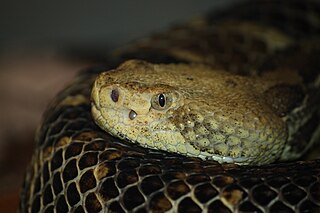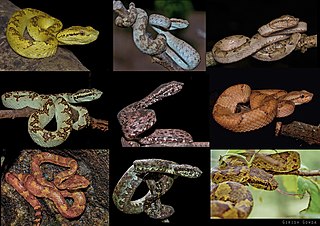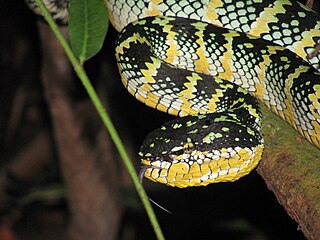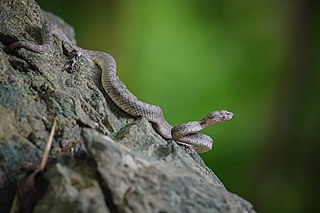
The Crotalinae, commonly known as pit vipers, or pit adders, are a subfamily of vipers found in Asia and the Americas. Like all other vipers, they are venomous. They are distinguished by the presence of a heat-sensing pit organ located between the eye and the nostril on both sides of the head. Currently, 23 genera and 155 species are recognized: These are also the only viperids found in the Americas. The groups of snakes represented here include rattlesnakes, lanceheads, and Asian pit vipers. The type genus for this subfamily is Crotalus, of which the type species is the timber rattlesnake, C. horridus.

Trimeresurus is a genus of venomous pit vipers found in Asia from the Indian Subcontinent throughout Southeast Asia, China, and the Pacific Islands. Currently 44 species are recognized. Common names include Asian palm pit vipers, Asian lanceheads, and green pit vipers.

Craspedocephalus strigatus, commonly known as the horseshoe pit viper, is a species of venomous snake in the subfamily Crotalinae of the family Viperidae. The species is endemic to the Western Ghats of India. There are no subspecies that are recognized as being valid.

Protobothrops jerdonii, also known commonly as Jerdon's pitviper, the yellow-speckled pit viper, and the oriental pit viper, is a species of venomous snake in the subfamily Crotalinae of the family Viperidae. The species is native to India, Nepal, Myanmar, China, and Vietnam. Three subspecies are recognized, including the nominate subspecies described here.

Trimeresurus albolabris, the white-lipped pit viper or white-lipped tree viper, is a venomous pit viper species endemic to Southeast Asia.
Trimeresurus cantori, commonly known as Cantor's pit viper or Cantor's pitviper, is a species of venomous snake, a pit viper in the Subfamily Crotalinae of the family Viperidae. The species is endemic to the Nicobar Islands of India. It was named after Theodore Edward Cantor (1809-1860), a Danish naturalist serving as a surgeon with the East India Company in Calcutta. No subspecies are recognized as being valid.

Craspedocephalus macrolepis, commonly known as the large-scaled pit viper, is a venomous pitviper species endemic to the Southern Western Ghats of South India. No subspecies are currently recognized.

Craspedocephalusmalabaricus, commonly known as Malabar pit viper, Malabar rock pit viper, or rock viper, is a venomous pit viper species endemic to the high-moderate elevations of Western Ghats of southwestern India. Recently this species complex was split into three different species, Craspedocephalus malabaricus, Craspedocephalus travancoricus, Craspedocephalus anamallensis.

Trimeresurus popeiorum is a species of venomous pit viper in the family Viperidae. The species is native to northern and northeastern parts of India and Southeast Asia. Common names include: Pope's pit viper, Pope's green pit viper, Pope's tree viper and Pope's bamboo pitviper.

Trimeresurus septentrionalis, commonly known as the Nepal pit viper or northern white-lipped pit viper, is a venomous pit viper species found in Bangladesh, Bhutan, Nepal and India.

Trimeresurus stejnegeri is a species of venomous pit viper endemic to Asia. Two subspecies are currently recognized, including the nominate subspecies described here.
Uropeltis dindigalensis, commonly known as the Dindigul uropeltis and the Sirumalai Hills earth snake, is a species of snake in the family Uropeltidae. The species is endemic to Sirumalai and surrounding hill ranges of the southern Eastern Ghats, in Dindigul district of Tamil Nadu state in South India.

Tropidolaemus is a genus of venomous pit vipers found in southern India and Southeast Asia. Currently, 5 species are recognised and no subspecies.

Tropidolaemus wagleri, more commonly known as Wagler's pit viper, is a species of venomous snake, a pit viper in the subfamily Crotalinae of the family Viperidae. The species is endemic to Southeast Asia. There are no subspecies that are recognized as being valid. It is sometimes referred to as the temple viper because of its abundance around the Temple of the Azure Cloud in Malaysia.

Trimeresurus kanburiensis is a species of pit viper found in only a few areas of Thailand. Common names include: Kanburi pitviper, Kanburian pit viper, and tiger pit viper. Highly venomous, it is an arboreal but heavily built species with a brown or tawny coloration. No subspecies are currently recognized.

Craspedocephalus brongersmai, also known commonly as Brongersma's pit viper, is a species of venomous snake in the subfamily Crotalinae of the family Viperidae. The species is native to islands off the west coast of Sumatra, Indonesia. No subspecies are currently recognized.
Angus Finlay Hutton was a British naturalist born in India. Working in the High Wavy range, he discovered a species of pit viper that is now named after him as Hutton's pit viper. He also collected a species of bat that was later named as Salim Ali's fruit bat after Indian ornithologist Salim Ali. Until his death is 2016, Hutton was the oldest living member of the Bombay Natural History Society (BNHS). He helped set up butterfly gardens in Southeast Asia before settling in Queensland, Australia.

Trimeresurus salazar, also known as Salazar's pit viper, is a species of venomous, green pit viper first discovered in 2019 in the lowlands of the western part of Arunachal Pradesh, India; the fifth new reptile species to be discovered in the region in 2019. It was named after Salazar Slytherin from the Harry Potter series. It has a dark green head and yellowish green dorsal scales on the rest of its body. The species is sexually dichromatic; the males have reddish-orange and yellow-orange stripes and a rusty red-orange tail that the females lack. Its habitat is under threat from human development activities.














